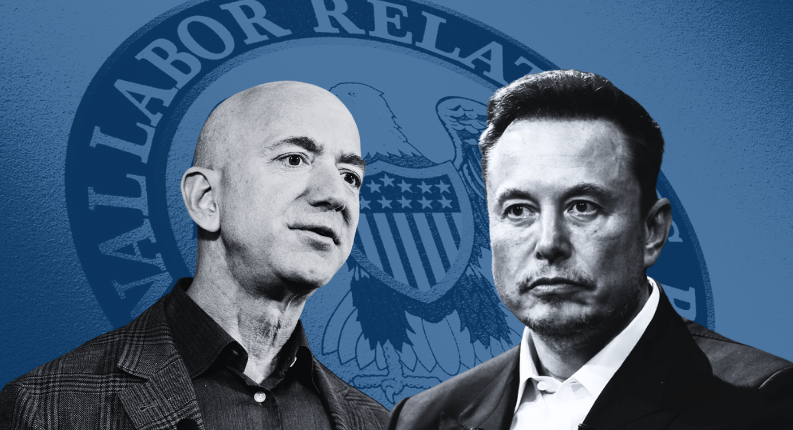The Changing Nature of Work: An Issue Brief on Contingent, Fissured and On-Demand Employment
By the Jobs With Justice Education Fund
Businesses aren’t just changing the way work is done; they’re increasingly altering the very foundation of work. More women and men are finding themselves in contingent and fissured work arrangements that often make it difficult to sustain their families because of lower pay, weak benefits, fewer rights, unpredictable hours and an indirect relationship with their “real boss.” This issue brief sheds more light on the growth of these less stable, insecure work arrangements, which corporations are using to replace the traditional employer-employee relationship in many industries.
Contingent Work
The phrase “contingent work” encompasses arrangements that are temporary and can lack the basic protections that workplace and civil rights laws typically afford only people employed in traditional, direct employer/employee work arrangements. This kind of arrangement is sometimes also referred to as “precarious work” to signify the insecure nature of contingent work.
The lack of a standard definition makes identifying and precisely measuring the contingent workforce difficult. At its essence, contingent work includes women and men in temporary work relationships. A more expansive definition of contingent work also includes those in nonstandard work arrangements or without consistent, full-time hours, even if the work assignment has an indefinite duration.
Regardless of the definition used, it’s clear from recent reports that the contingent workforce continues to expand in the United States and across the world.
The U.S. Government Accountability Office (GAO) recently estimated the core U.S. contingent workforce accounts for eight percent of the total employed workforce, using a definition that incorporates those “who lack job security and those with work schedules that are variable, unpredictable, or both…”[1] Americans working as temporary agency employees, direct-hire temporary employees, on-call employees and day laborers exemplify this definition of contingent work.
Contingent work arrangements aren’t limited to just lower skilled jobs. For instance, a majority of today’s college faculty are adjunct instructors who lack the guarantee of continued employment from one semester to the next. That’s a dramatic shift in the employment model for professors from 1969, when nearly 80 percent of college instructors were tenured or on a tenure track.
Contingent Work and Immigration
While not necessarily identified in the various national surveys used to measure contingent employment, the women and men hired through the U.S. temporary guestworker visa programs are perhaps the quintessential contingent workforce. These individuals are hired to work only for a set period of months or years, depending on the employer and the visa program. Employers have recognized that they can use the guestworker visa programs to their advantage by hiring a crop of employees who are essentially never in a position to demand higher pay or better benefits, since the employer/employee relationship ends with the conclusion of the work assignment. The experience of guestworkers, from H-2B seafood processers to H-1B systems analysts, demonstrates the insecure nature of contingent employment. Corporations from Southern Cal Edison to Disney use guestworker programs to replace U.S. employees with a contracted, contingent workforce. And in doing so, these companies exemplify how many businesses have moved beyond the original intent of the guestworker visa programs, which was to provide employers with access to employees when U.S. workers are not available.
Fissured Work
Some jobs fall between traditional and contingent employment. Dr. David Weil, the director of the U.S. Department of Labor’s Wage and Hour division, coined the term “fissured work” to identify and group such work arrangements that may have a traditional employee/employer structure, but exhibit much of the insecurity associated with contingent work. Women and men in fissured work arrangements may not be counted as part of the contingent workforce despite having similar characteristics, including greater job insecurity, lower pay and less access to benefits.
For example, the individuals who move products in warehouses along Walmart’s supply chain do not receive a paycheck from the retail behemoth, yet Walmart dictates the standards and practices that establish the warehouse workers’ pay and working conditions. The same is true for employees of McDonald’s franchisees. McDonald’s does not issue paychecks to these employees, but the way the employees are compensated and the way they do their work is inherently influenced and, for aspects of the job, nearly fully directed by McDonald’s Corporation. Likewise, third-party housekeepers clean the rooms of Hyatt hotels for guests. Despite performing an essential hospitality operation, the housekeepers are not legally employed by the hotel giant – even though the work is done to Hyatt’s standards and specifications.
The growth of fissured work comes as more and more companies rearrange their organizations to focus only on “core competencies,” the unique services and operations believed to distinguish a company in the marketplace and, therefore, drive profits. Technological advances have facilitated the ability of corporations to dictate standards and closely monitor their implementation across locations. In turn, this ability to more closely control and track the activity of outside firms has allowed companies to broaden the scope of work deemed not to be a core competency. Companies are increasingly outsourcing more and more work through a variety of contractual arrangements with subordinate firms, including subcontracting, franchising and multitiered supply chains. These arrangements allow companies to divest themselves of employment responsibility for workers carrying out tasks for which the corporations primarily benefit. At the same time, the subordinate firms are in constant competition for these contracts, driving down costs for the primary companies, as well as wages for the subordinate firms’ employees.
Fissured work arrangements are not inherently bad. Industries from construction to manufacturing rely on the coordination of different firms with unique areas of specialization to create sophisticated products. However, high-stakes competition among businesses to win and maintain outsourcing contracts creates an incentive to push down labor costs and cut corners with employer responsibilities, such as misclassifying employees as independent contractors and violating wage and hour laws. That is especially true when the only “specialization” subordinate firms can offer is a lower cost. And with little to no legal responsibility for what goes on in these fissured workplaces, the primary businesses – often large, profitable corporations – have a reason to look the other way. For instance, researchers found that fast food establishments that are directly owned by a brand have higher Fair Labor Standards Act (FLSA) compliance rates than franchisee-owned stores. A typical franchised fast food store owed more than $4,000 in back wages compared to a company-owned restaurant. And in the hospitality industry, hotels managed by brand-name chains are more likely to have higher FLSA compliance rates than franchisee counterparts.
Work in the On-Demand Economy
The on-demand economy refers to the recent rise of startups that provide services like chauffeuring and cleaning in immediate or near-immediate response to consumer demand. Most of these companies claim they simply connect consumers with service providers and, thus, are not employers. Yet many of the employment practices found in the on-demand economy are tried-and-true attempts to shift work from traditional to contingent employment relationships in an effort to shed employment responsibility. When Uber says its drivers are independent contractors, it is using a similar rationale as FedEx does when it labels – and arguably misclassifies – its FedEx Ground drivers as independent contractors.
The on-demand economy’s current predominant employment model enables corporations to maintain control of the operations happening under their brands, reap the profits from those operations, while also fully divesting themselves of the responsibilities of employing those women and men needed for their businesses to succeed. These more precarious work arrangements also can leave companies exposed to significant liability under employment and tax laws. However, fissured and contingent work arrangements are not a prerequisite for business success in the on-demand economy. Perhaps because of these factors, Instacart and a growing number of on-demand companies have reversed course, reclassifying its independent contractor workforce as employees.
Conclusion
The protections of our current labor and employment laws should carry forward to protect those hired into modern work arrangements. That means more firms should be liable for the working conditions of the temporary, franchise and subcontracted employees whose labor they ultimately control. More people should be considered employees and benefit from the rights and protection that come with that designation. Our labor and employment laws should have a broader definition of employee and joint employment. This not only benefits employees, but benefits all taxpayers who are not left to foot the bill for the social safety net, including Medicare and Social Security, which becomes necessary when employers skirt their responsibilities.
Just because the nature of work is changing from its more traditional form, working Americans should not have to accept that their job standards must subside. While work changes, the need for a fair return on work endures.
[1] GAO, 2015, p. 4
Download as a PDF: The Changing Nature of Work









We can start with protecting our citizens from job theft. Rural areas are vulnerable in meat cutting, multinational owned refineries and construction. All of these need inspectors and limits on non US workers. Other countries do this and we need not copy the United Arab Emirates and Saudi Arabian labor laws about exploiting foreign workers. People can only exist on handouts for so long. They need a pro labor environment.